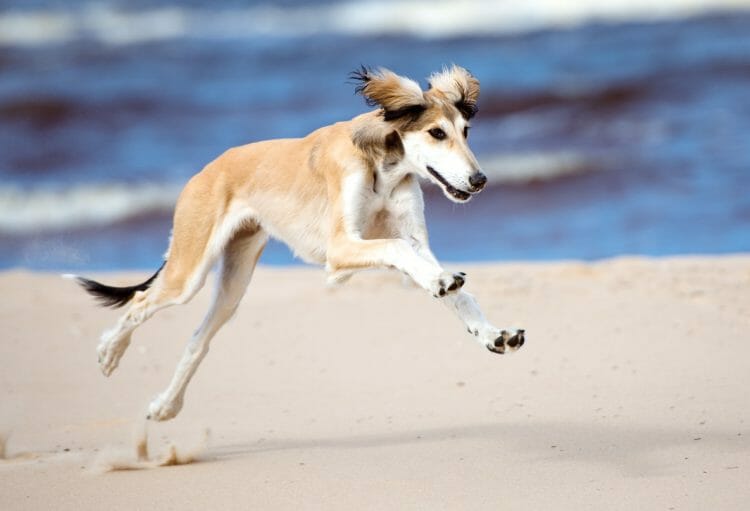Saluki Dog

What Is a Saluki Dog?
Also known as the Persian Greyhound, the Saluki dog has a long history of being used to hunt gazelles. Featured in the Guinness Book of Records as the oldest canine breed in the world, these enthusiastic predators hunt using sight instead of scent.
Built for endurance and speed, the Saluki is not only fast but is able to maintain its pace for prolonged periods of time while covering vast distances. With a tall sleek body, the noble-looking Saluki resembles a greyhound in many respects. However, it often has long, feathered hair accentuating its ears and limbs.

Saluki Dog History
Saluki can trace their origins back to the cradle of civilization. Images of hunting dogs that bear a striking resemblance to the breed have been found in Sumerian wall carvings. These carvings are believed to date back to between 7000 BC and 6000 BC. Skeletal remains of a Saluki were also excavated in Syria. The bones were believed to be 4,000 years old.
In ancient Egypt, images of Salukis were used on tombs during the time of the Middle Kingdom (2134 BC to 1785 BC). In Egypt’s Eighteenth Dynasty (1549 BC to 1292 BC), the Saluki became the dominant hunting dog, and the breed spread south toward Sudan.
Salukis also found their way further east—making their way to China by way of the Silk Road. Salukis appeared in paintings by the fifth Ming Emperor Zhū Zhānjī.
Soldiers returning to Europe from the crusades brought Salukis home with them. A famous painting from the 16th century depicts Henry IV, the Duke of Saxony, with a Saluki wearing a scallop shell pilgrim badge. The badge indicated that the dog had made a pilgrimage to the Way of Saint James in Spain.
Salukis have also long been the favored breed of the nomadic Bedouin tribes. Although Muslims usually regard dogs as being unclean, the Saluki is held in high regard and is believed to be a gift from Allah. The Saluki is the only type of dog allowed inside a Bedouin tent and, in particular, the women’s quarters.

What Does a Saluki Dog Look Like?
The Saluki dog breed closely resembles greyhounds in terms of build. The breed is characterized by long, slim legs, a thin body, an arched loin, a deep chest, a narrow waist, and a long tail, Salukis differ from greyhounds in their angular appearance. Usually, the hip bones, vertebrae, and the last three ribs of the dog will be visible.
Salukis stand between 23 and 28 inches tall, with most dogs at the highest end of the range. Females weigh around 35 pounds, while males can weigh as much as 65 pounds.
A feathered Saluki will have flowing silky locks of hair on its ears, beneath the tail, and around the toes. Occasionally, the hair will also appear on the underside of the throat and on the backs of its limbs. The remaining coat is short. Although the feathered Saluki may be regarded as the standard for the breed, these dogs can also have short, smooth coats that can be of any color.

Saluki Dog Personality
Salukis are gentle companions that often bond with a specific person. This does mean that the breed tends to develop separation anxiety. Stress within the home can also cause anxiety to the sensitive Saluki.
When meeting a stranger, a Saluki will be reserved. This means that socialization is essential from an early age as these canines tend to be shy. Generally, the breed gets along well with dogs, particularly other Salukis and sighthounds. Unlike many canines, cleanliness is important to a Saluki.
Living with families including young children poses no issue for the Saluki. They can even get used to cats within the home. However, due to the breed’s innate hunting instinct, care should be taken introducing the dog to any unfamiliar animals.

How to Care for a Saluki Dog
Famed for its ability to chase gazelles, the Saluki is a fit and agile breed. Owners need to be aware of the physical needs of this dog and must be prepared to provide adequate exercise.
When walking a Saluki, it is important that the dog always remains on its leash. A Saluki is fast and has a finely tuned prey drive. This means it will give chase to anything that catches its attention.
Mental stimulation is also important. Be sure to provide plenty of toys and activities to keep the Saluki from becoming bored. When boredom sets in, these dogs can become restless and destructive.
Salukis are quite independent and strong-minded, which means they may be difficult to train. The breed’s rapid response to the presence of prey means they often act without waiting for commands. When attempting to train a Saluki, the best results will always be achieved using positive reinforcement techniques.

Saluki Dog Health
Due to their long-established genetic line, there are few hereditary diseases that affect Salukis. They typically live long, active lives. However, owners should be mindful of the potential for enlarged hearts and arrhythmias.
Blood conditions, autoimmune disorders, and cancers (such as osteosarcoma, hemangiosarcoma, or lymphoma) can also affect this breed.
Due to the intensity with which the Saluki runs, it is important to take care to prevent bloat. Also known as gastric torsion, this life-threatening condition occurs when the stomach becomes twisted. It most often occurs when a dog exercises too soon after a meal.
Signs of Bloat
- Restlessness
- Distended abdomen
- Pacing
- Drooling
- Rapid breathing or panting
- Visible distress
If a dog displays any of signs of bloat, seek veterinary attention immediately.
Finding Saluki Dogs for Sale
The Saluki dog price can often be as high as $3,000. However, when looking for any pet, it is always best to adopt. Countless dogs are given up for adoption each year and are looking for a loving new home. Look for a specialist Saluki dog rescue shelter or a general adoption center that has the breed in their kennels. Remember to ensure to adopt from a no kill shelter. Centers such as these have strict policies to never put a healthy animal down.
Additional larger breed dogs include the Weimaraner, Vizsla, and the Irish Red and White Setter.



